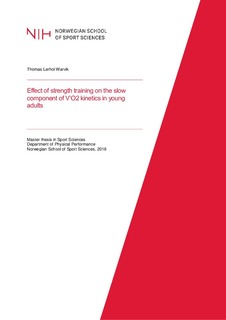Effect of strength training on the slow component of V’O2 kinetics in young adults
Master thesis
Permanent lenke
http://hdl.handle.net/11250/2504426Utgivelsesdato
2018Metadata
Vis full innførselSamlinger
Sammendrag
Background: When performing exercise above gas exchange threshold, we attain oxygen uptake at steady state, with a delay due to the appearance of a slow component of V̇ O2 kinetics that usually starts 150 – 200 s after exercise onset. The slow component is related to the loss of homeostasis and to the increased susceptibility to fatigue. Studies suggests that the progressive recruitment of type II fibers during heavy exercise is the main determinant due to high ATP cost and O2 consumption. Strength training leads to a decrease in the numbers of motor units recruited at the same work-rate and may attenuate the slow component as a smaller number of less efficient type II fibers are recruited at the same work-rate. This paper investigated whether the slow component is determined by the progressive recruitment of type II fiber, or rather by the decay of efficiency of already recruited fibers.
Methods: 7 male subjects (age: 24 ± 3 years, height: 185 ± 3 cm, weight: 83 ± 14 kg) completed 6-weeks of one leg strength training on the quadriceps, while the other leg worked as a control. The subjects performed maximum one leg kicking test to determine 50 % and 80 % of WLmax before the training intervention, and then tested the same absolute work-rate pre- and post. Both V̇ O2 and muscle activation were measured. Maximum isokinetic and isometric strength were also measured before and after the training intervention.
Beskrivelse
Masteroppgave - Norges idrettshøgskole, 2018
